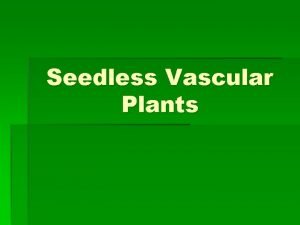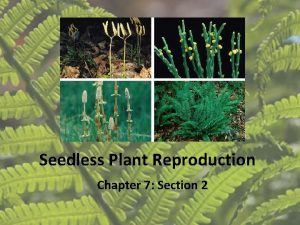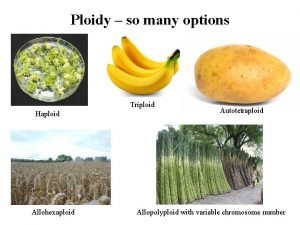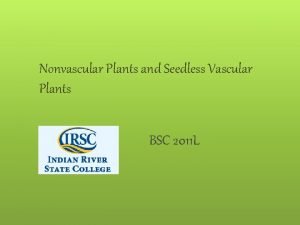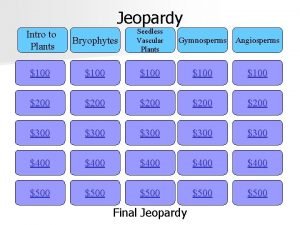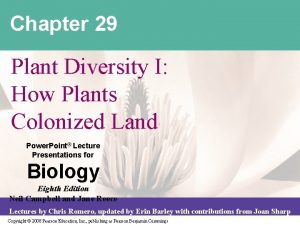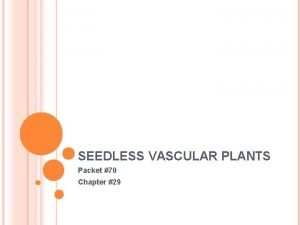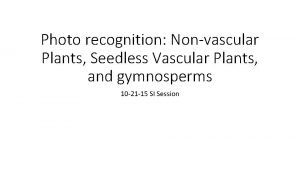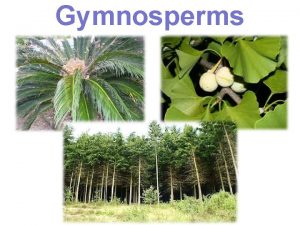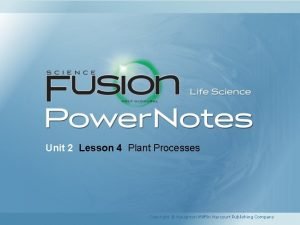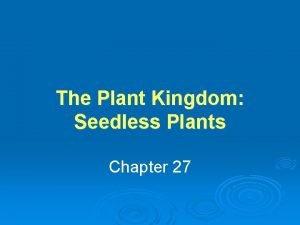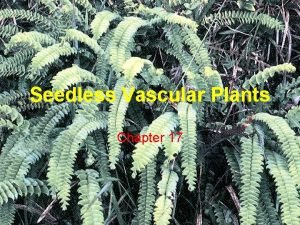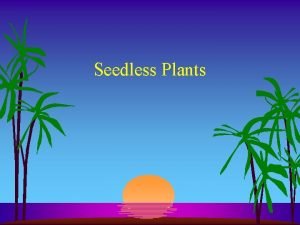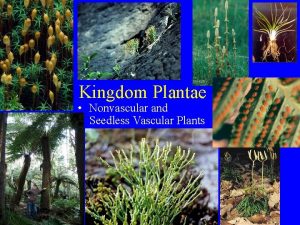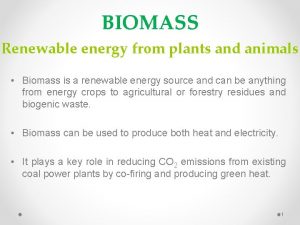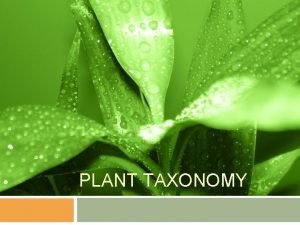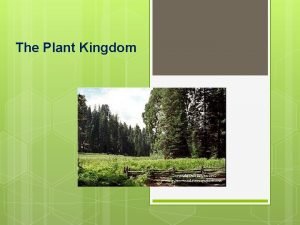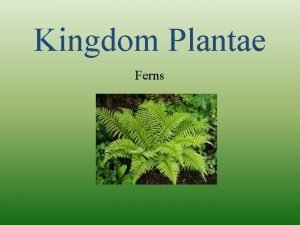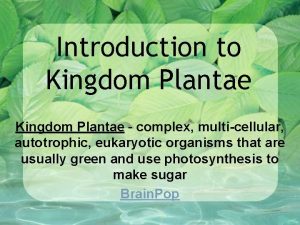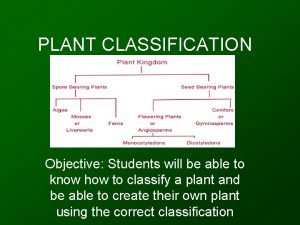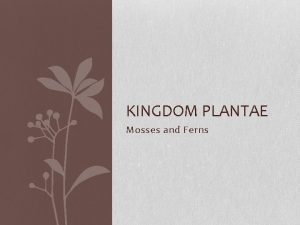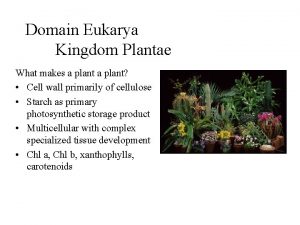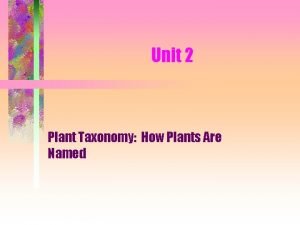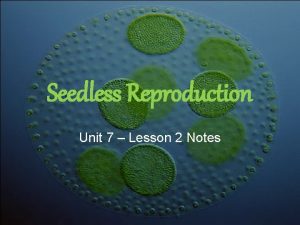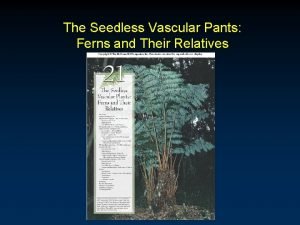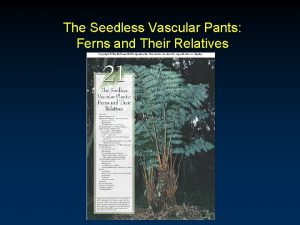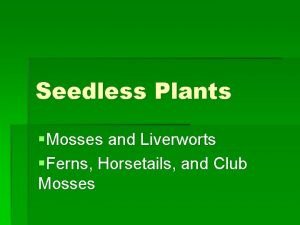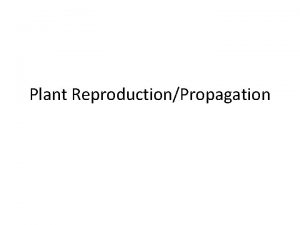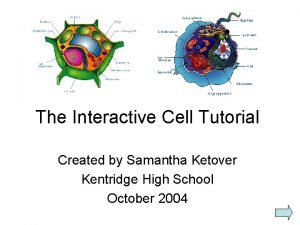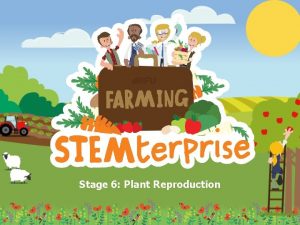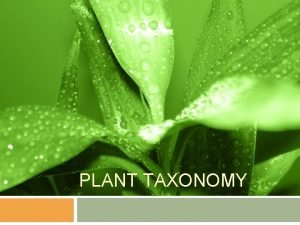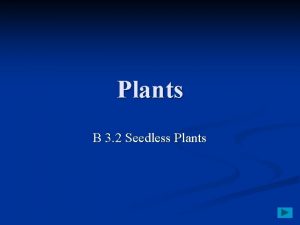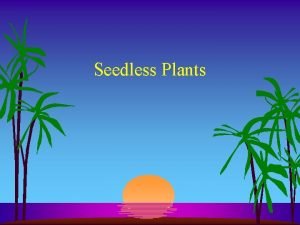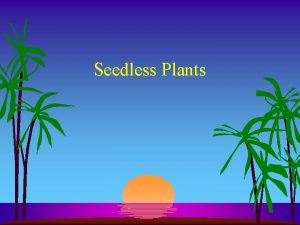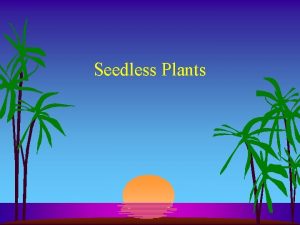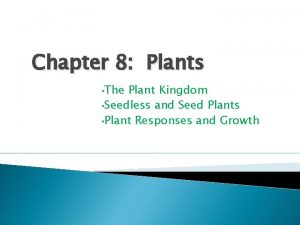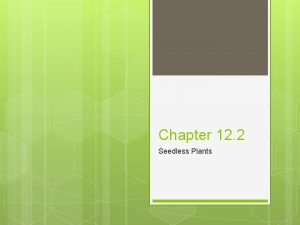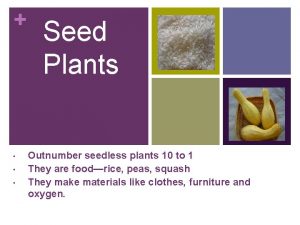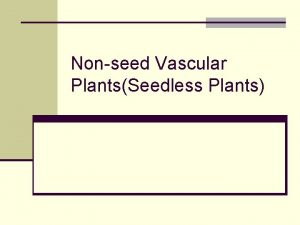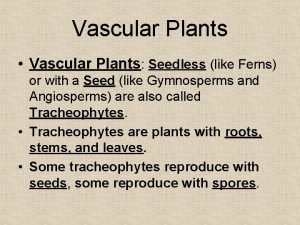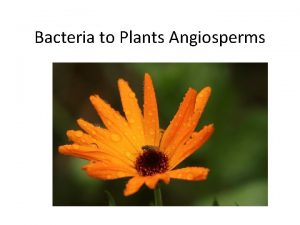The Plant Kingdom Seedless Plants Chapter 27 Learning






















































































- Slides: 86

The Plant Kingdom: Seedless Plants Chapter 27

Learning Objective 1 • What are some environmental challenges of living on land? • How do some plant adaptations meet these challenges?

Colonization of Land by Plants • Required anatomical, physiological, and reproductive adaptations • Waxy cuticle • • protects against water loss Stomata • for gas exchange needed for photosynthesis

Alternation of Generations 1 • 2 parts of plant life cycle • • • haploid gametophyte generation diploid sporophyte generation Gametophyte plant • • produces gametes by mitosis gametes fuse (fertilization) to form zygote (first stage of sporophyte generation)

Basic Plant Life Cycle

Gametophyte Spore Sperm Egg HAPLOID (n) GAMETOPHYTE GENERATION Meiosis Fertilization DIPLOID (2 n) SPOROPHYTE GENERATION Zygote Embryo Sporophyte Fig. 27 -2, p. 582

Gametophyte Spore Sperm Egg HAPLOID (n) GAMETOPHYTE GENERATION Meiosis Fertilization DIPLOID (2 n) SPOROPHYTE GENERATION Zygote Sporophyte Embryo Stepped Art Fig. 27 -2, p. 582

Alternation of Generations 2 • Zygote develops into multicellular embryo • • protected and nourished by gametophyte Mature sporophyte plant • • develops from the embryo produces sporogenous cells (spore mother cells)

Alternation of Generations 3 • Sporogenous cells undergo meiosis to form spores • first stage in gametophyte generation

KEY CONCEPTS • Plants undergo an alternation of generations between multicellular gametophyte and sporophyte generations

Gametangia 1 • Most plants have multicellular gametangia • with protective jacket of sterile cells surrounding gametes

Gametangia 2 • Antheridia • • gametangia that produce sperm cells Archegonia • gametangia that produce eggs

Gametangia

Developing sperm cells Sterile cells Antheridium Fig. 27 -3 a, p. 583

Egg Sterile cells Archegonium Fig. 27 -3 b, p. 583

Vascular Transport System • In ferns and other vascular plants • • xylem conducts water and dissolved minerals phloem conducts dissolved sugar

KEY CONCEPTS • Adaptations to life on land that have evolved in plants include a waxy cuticle to prevent water loss; multicellular gametangia; stomata; and for most plants, vascular tissues containing lignin

Learning Objective 2 • From which green algal group are plants hypothesized to have descended? • Describe supporting evidence

Charophytes • Plants probably arose from charophytes • • a group of green algae Based on molecular comparisons of DNA and RNA sequences • close match between charophytes and plants

Plant Evolution

Angiosperms Gymnosperms Ferns Mosses Liverworts Hornworts Club mosses VASCULAR SEEDLESSVASCULAR SEED PLANTS NONVASCULAR BRYOPHYTES Evolution of seeds Evolution of dominant sporophyte, vascular tissue Green algal ancestor Evolution of cuticle, multicellular gametangia, multicellular embryos Fig. 27 -4, p. 584

KEY CONCEPTS • Biologists infer that plants evolved from aquatic green algal ancestors known as a charophytes

Insert “Evolutionary tree for plants” plant_tree_v 2. swf

Explore plant evolution by clicking on the figure in Thomson. NOW.

Learning Objective 3 • What features distinguish bryophytes from other plants?

Bryophytes • Nonvascular (lack xylem and phloem) • • Dominant gametophyte generation • • unlike other land plants unlike other plants Sporophytes remain permanently attached • nutritionally dependent on gametophytes

Learning Objective 4 • What are three phyla of bryophytes?

Mosses (Phylum Bryophyta) • Gametophytes are green plants that grow from a filamentous protonema

Liverworts (Phylum Hepatophyta) • Many gametophytes are flattened, lobelike thalli (others are leafy)

Hornworts (Phylum Anthocerophyta) • Have thalloid gametophytes

Fig. 27 -5, p. 585

Green algal ancestor Fig. 27 -5 (1), p. 585 Vascular seed plants Vascular seedless plants Nonvascular bryophytes

KEY CONCEPTS • Mosses and other bryophytes lack vascular tissues and do not form true roots, stems, or leaves

Learning Objective 5 • Describe the life cycle of mosses • Compare their gametophyte and sporophyte generations

Mosses 1 • Green moss gametophyte • • bears archegonia / antheridia at top of plant Fertilization • sperm cell fuses with egg cell in archegonium (zygote)

Mosses 2 • Zygote • • grows into embryo develops into moss sporophyte attached to gametophyte

Mosses 3 • Meiosis • • • occurs within capsule of sporophyte produces spores When spore germinates • • grows into a protonema forms buds that develop into gametophytes

Moss Life Cycle

Gametophyte plants Buds on protonema Antheridia at the tip of the gametophyte shoot Antheridia with sperm cells 1 Spore germinates Spores released 6 Protonema HAPLOID (n) GAMETOPHYTE GENERATION Sperm cell 2 Archegonium with egg Fertilization Meiosis DIPLOID (2 n) SPOROPHYTE GENERATION 5 Calyptra Sporogenous cells that undergo meiosis Capsule Zygote 4 Sporophyte 3 Embryo Gametophyte plant Fig. 27 -6, p. 586

Moss Sporophytes

Capsule Seta Foot Fig. 27 -7, p. 587

Liverwort Life Cycle

Antheridiophore Archegoniophore Male thallus Female thallus Germination of spores and development of young gametophyte 5 1 Antheridia with sperm cells Gemmae cup Spores released Sperm cell Male and female gametophyte plants HAPLOID (n) GAMETOPHYTE GENERATION Meiosis Archegonia with eggs 2 Fertilization DIPLOID (2 n) SPOROPHYTE GENERATION 4 Foot Seta Zygote Tissue derived from archegonium Capsule Sporogenous cells that undergo meiosis Embryo 3 Sporophyte Fig. 27 -8, p. 588

Insert “Moss life cycle” moss_life_cycle_v 2. swf

Insert “Marchantia, a liverwort” liverwort. swf

Watch the life cycles of the mosses and liverworts by clicking on the figures in Thomson. NOW.

Learning Objective 6 • What features distinguish seedless vascular plants from algae and bryophytes?

Seedless Vascular Plants • Have adaptations that algae and bryophytes lack • • • vascular tissues dominant sporophyte generation Reproduction depends on water • as transport medium for motile sperm cells (as in bryophytes)

Learning Objective 7 • What are the two phyla of seedless vascular plants?

Club Mosses (Phylum Lycopodiophyta) • Sporophytes consist of roots, rhizomes, erect branches, and microphylls (leaves)

Stem Microphyll Vascular tissue Enation Vein Smooth stem Enation Vascular supply to enation Microphyll (one vein) Fig. 27 -10 a, p. 590

Club Mosses

Green algal ancestor Fig. 27 -11 (1), p. 591 Vascular seed plants Vascular seedless plants Nonvascular bryophytes

Strobilus Leaves (microphylls) Fig. 27 -11 (a-b), p. 591

Ferns (Phylum Pteridophyta) • Largest and most diverse group of seedless vascular plants • Fern sporophyte consists of a rhizome that bears fronds and true roots • Includes whisk ferns and horsetails

Ferns

Green algal ancestor Fig. 27 -12 (1), p. 592 Vascular seed plants Vascular seedless plants Nonvascular bryophytes

Fig. 27 -12 a, p. 592

Fig. 27 -12 b, p. 592

Fig. 27 -12 c, p. 592

Fern Life Cycle

Underside of enlarged mature gametophyte (prothallus) Germination of spores and development of young gametophyte Egg 5 4 Spores released Rhizoids 3 Antheridium Sporangium Meiosis Sorus 2 (cluster of sporangia) Archegonium HAPLOID (n) GAMETOPHYTE GENERATION Sperm cell Fertilization Cells within DIPLOID (2 n) SPOROPHYTE sporangia GENERATION undergo meiosis Frond 1 Zygote 6 Leaf of young sporophyte Leaf cross section Fiddlehead Roots Underside of a frond Rhizome Fern (mature sporophyte) Development of the sporophyte Haploid prothallus Root of young sporophyte Fig. 27 -13, p. 593

Whisk Ferns • Sporophytes have dichotomously branching rhizomes and erect stems • lack true roots and leaves

Green algal ancestor Fig. 27 -14 a, p. 594 Vascular seed plants Vascular seedless plants Nonvascular bryophytes

Sporangia Aerial stem with scalelike outgrowths (no leaves) Fig. 27 -14 b, p. 594

Horsetails • Sporophytes have • • hollow, jointed roots, rhizomes, aerial stems leaves reduced to megaphylls

Thicker main Dichotomous stem end branches Equal branches Vascular tissue Dichotomously branching stems Overtopping (unequal branching) Thinner side branch Planation (branching in same plane) Webbing of side branch system Megaphyll (many veins) Fig. 27 -10 b, p. 590

Horsetails

Green algal ancestor Fig. 27 -15 a, p. 594 Vascular seed plants Vascular seedless plants Nonvascular bryophytes

Strobilus Vegetative shoots Reproductive shoots Fig. 27 -15 b, p. 594

Insert “Seedless vascular plants” seedless_vascular. swf

KEY CONCEPTS • In club mosses and ferns, lignin-hardened vascular tissues that transport water and dissolved substances throughout the plant body have evolved

Learning Objective 8 • Describe the life cycle of ferns • Compare sporophyte and gametophyte generations

Fern Sporophytes • Roots, rhizomes, leaves are megaphylls • Leaves (fronds) bear sporangia in clusters (sori) • Meiosis in sporangia produces haploid spores

Fern Gametophyte • Fern Gametophyte (prothallus) • • develops from haploid spore bears both archegonia and antheridia

Insert “Fern life cycle” fern_life_cycle_v 2. swf

Watch the life cycle of the ferns by clicking on the figure in Thomson. NOW.

Learning Objective 9 • What is the difference between the generalized life cycles of homosporous and heterosporous plants?

Homospory • Production of one kind of spore • • in bryophytes, most club mosses, most ferns including whisk ferns and horsetails Spores give rise to gametophyte plants • produce both egg cells and sperm cells

Heterospory 1 • Production of two kinds of spores (microspores and megaspores) • • in some club mosses and ferns in all seed plants

Heterosporous Life Cycle

Gametophyte Megaspore Gametophyte Microspore Archegonium Antheridium Sperm Egg HAPLOID (n) GAMETOPHYTE GENERATION Fertilization DIPLOID (2 n) SPOROPHYTE GENERATION Meiosis Microsporocyte Megasporocyte Zygote Microsporangium Embryo Megasporangium Sporophyte Fig. 27 -16, p. 595

Heterospory 2 • Microspores • • give rise to male gametophytes that produce sperm cells Megaspores • give rise to female gametophytes that produce eggs

Selaginella Life Cycle

Male gametophyte develops inside microspore wall Single antheridium in male gametophyte produces many sperm cells 3 Ruptured megaspore wall Microspores 5 Archegonium containing egg Female gametophyte develops and protrudes from megaspore wall 4 Megaspores Meiosis Sperm cell HAPLOID (n) GAMETOPHYTE GENERATION Microsporangium DIPLOID (2 n) with microsporocytes SPOROPHYTE GENERATION Longitudinal section through archegonium Egg Fertilization Female Strobilus gametophyte First Leaf leaves (microphyll) Stem Megasporangium with megasporocyte 1 Stem Longitudinal section through strobilus Root Mature sporophyte 6 Zygote Young sporophyte (attached to female gametophyte) Fig. 27 -17, p. 596

Evolution of Heterospory • Essential step in evolution of seeds • Rhynia • Aglaophyton
 Old kingdom middle kingdom new kingdom
Old kingdom middle kingdom new kingdom Nnn ruled
Nnn ruled Roman empire
Roman empire Old kingdom middle kingdom new kingdom
Old kingdom middle kingdom new kingdom Seedless vascular plant life cycle
Seedless vascular plant life cycle How seedless plants reproduce
How seedless plants reproduce Wheat
Wheat Which seedless plants have been used to treat bee stings
Which seedless plants have been used to treat bee stings Nonvascular plant
Nonvascular plant Heterosporous vs homosporous
Heterosporous vs homosporous Seedless nonvascular plants
Seedless nonvascular plants Charophytes characteristics
Charophytes characteristics Sprophytes
Sprophytes Seedless vascular plants
Seedless vascular plants Seeded vascular plants
Seeded vascular plants Unit 2 lesson 12 flowering plants
Unit 2 lesson 12 flowering plants Microphylls
Microphylls Vascular plants
Vascular plants Multicellular dependent embryos
Multicellular dependent embryos Do seedless plants have cell walls made of cellulose
Do seedless plants have cell walls made of cellulose Seedless vascular plants phylum
Seedless vascular plants phylum Seedless plant reproduction
Seedless plant reproduction Advantages of biomass
Advantages of biomass Seedless vascular plant
Seedless vascular plant Kingdom fungi and kingdom plantae similarities
Kingdom fungi and kingdom plantae similarities Share
Share Kingdom protista
Kingdom protista Trichomoniasis
Trichomoniasis 5 characteristics of plants.
5 characteristics of plants. What non vascular plants
What non vascular plants Non vascular plant reproduction
Non vascular plant reproduction Classify flowering and nonflowering plants
Classify flowering and nonflowering plants C3 plant
C3 plant Cuadro comparativo e-learning y b-learning
Cuadro comparativo e-learning y b-learning Maize kingdom
Maize kingdom Plant kingdom characteristics
Plant kingdom characteristics Plant kingdom
Plant kingdom Kingdom of ferns
Kingdom of ferns Multicellular autotrophic eukaryotic
Multicellular autotrophic eukaryotic Types of eubacteria
Types of eubacteria Plant classification
Plant classification Kingdom of mosses
Kingdom of mosses Domain of kingdom plantae
Domain of kingdom plantae How plants are named
How plants are named Seedless reproduction
Seedless reproduction Phylum lycophyta
Phylum lycophyta Phylum polypodiophyta
Phylum polypodiophyta Ferns horsetails and club mosses
Ferns horsetails and club mosses Sugraone seedless
Sugraone seedless Scope of plant breeding
Scope of plant breeding Plant breeding for disease resistance
Plant breeding for disease resistance Plant introduction in plant breeding
Plant introduction in plant breeding Tronsmo plant pathology and plant diseases download
Tronsmo plant pathology and plant diseases download Tronsmo plant pathology and plant diseases download
Tronsmo plant pathology and plant diseases download Tronsmo plant pathology and plant diseases download
Tronsmo plant pathology and plant diseases download Little kingdom daycare
Little kingdom daycare Learning outcomes of photosynthesis
Learning outcomes of photosynthesis Learning objectives of reproduction in plants
Learning objectives of reproduction in plants Structure of xylem
Structure of xylem Samantha ketover
Samantha ketover Learning objectives of reproduction in plants
Learning objectives of reproduction in plants Objectives of plant taxonomy
Objectives of plant taxonomy Hát kết hợp bộ gõ cơ thể
Hát kết hợp bộ gõ cơ thể Lp html
Lp html Bổ thể
Bổ thể Tỉ lệ cơ thể trẻ em
Tỉ lệ cơ thể trẻ em Voi kéo gỗ như thế nào
Voi kéo gỗ như thế nào Tư thế worm breton là gì
Tư thế worm breton là gì Bài hát chúa yêu trần thế alleluia
Bài hát chúa yêu trần thế alleluia Môn thể thao bắt đầu bằng chữ đua
Môn thể thao bắt đầu bằng chữ đua Thế nào là hệ số cao nhất
Thế nào là hệ số cao nhất Các châu lục và đại dương trên thế giới
Các châu lục và đại dương trên thế giới Cong thức tính động năng
Cong thức tính động năng Trời xanh đây là của chúng ta thể thơ
Trời xanh đây là của chúng ta thể thơ Mật thư tọa độ 5x5
Mật thư tọa độ 5x5 101012 bằng
101012 bằng Phản ứng thế ankan
Phản ứng thế ankan Các châu lục và đại dương trên thế giới
Các châu lục và đại dương trên thế giới Thơ thất ngôn tứ tuyệt đường luật
Thơ thất ngôn tứ tuyệt đường luật Quá trình desamine hóa có thể tạo ra
Quá trình desamine hóa có thể tạo ra Một số thể thơ truyền thống
Một số thể thơ truyền thống Cái miệng nó xinh thế chỉ nói điều hay thôi
Cái miệng nó xinh thế chỉ nói điều hay thôi Vẽ hình chiếu vuông góc của vật thể sau
Vẽ hình chiếu vuông góc của vật thể sau Biện pháp chống mỏi cơ
Biện pháp chống mỏi cơ đặc điểm cơ thể của người tối cổ
đặc điểm cơ thể của người tối cổ Giọng cùng tên là
Giọng cùng tên là Vẽ hình chiếu đứng bằng cạnh của vật thể
Vẽ hình chiếu đứng bằng cạnh của vật thể




